Human Development: Psychosocial Development Stages Analysis
VerifiedAdded on 2022/10/13
|6
|1707
|12
Essay
AI Summary
This essay explores the stages of human development, focusing on the psychosocial development theory, particularly Erikson's stages. It delves into the conflicts experienced during different stages, such as autonomy versus shame and initiative versus guilt, and their impact on personality development. The essay highlights the significance of social interaction, parenting styles, and the resolution of conflicts in shaping an individual's psychosocial strengths. It emphasizes the critical role of caregivers and parents in guiding children through these stages, providing examples and referencing relevant theories like Bowlby's attachment theory. The analysis covers the importance of successful development at each early stage for later life, and the consequences of failing to effectively manage developmental conflicts. The essay discusses how cultural differences influence parenting standards and expectations, and how these factors affect a child's development. References from academic sources are included to support the arguments presented, providing a comprehensive overview of the key concepts in human development.
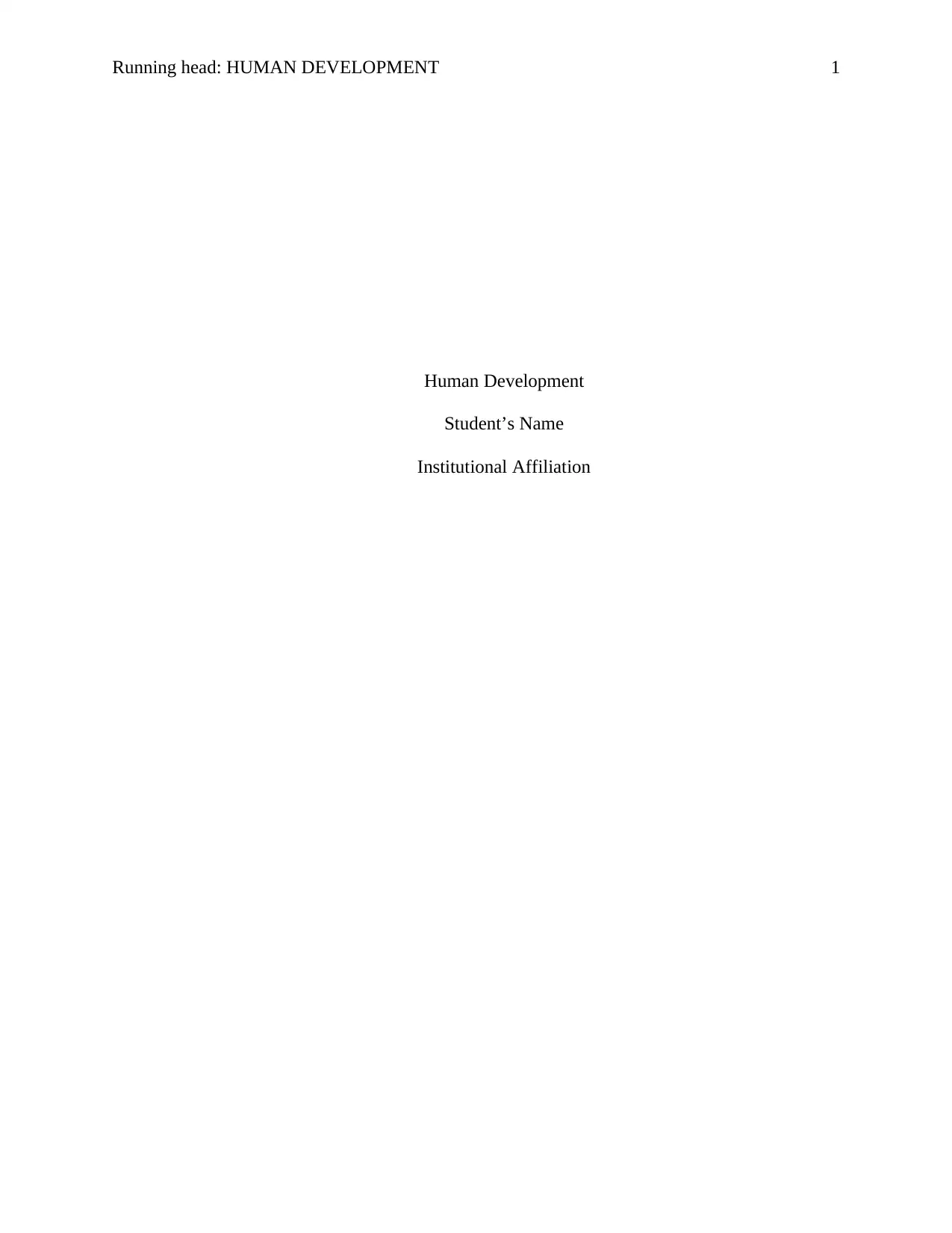
Running head: HUMAN DEVELOPMENT 1
Human Development
Student’s Name
Institutional Affiliation
Human Development
Student’s Name
Institutional Affiliation
Paraphrase This Document
Need a fresh take? Get an instant paraphrase of this document with our AI Paraphraser
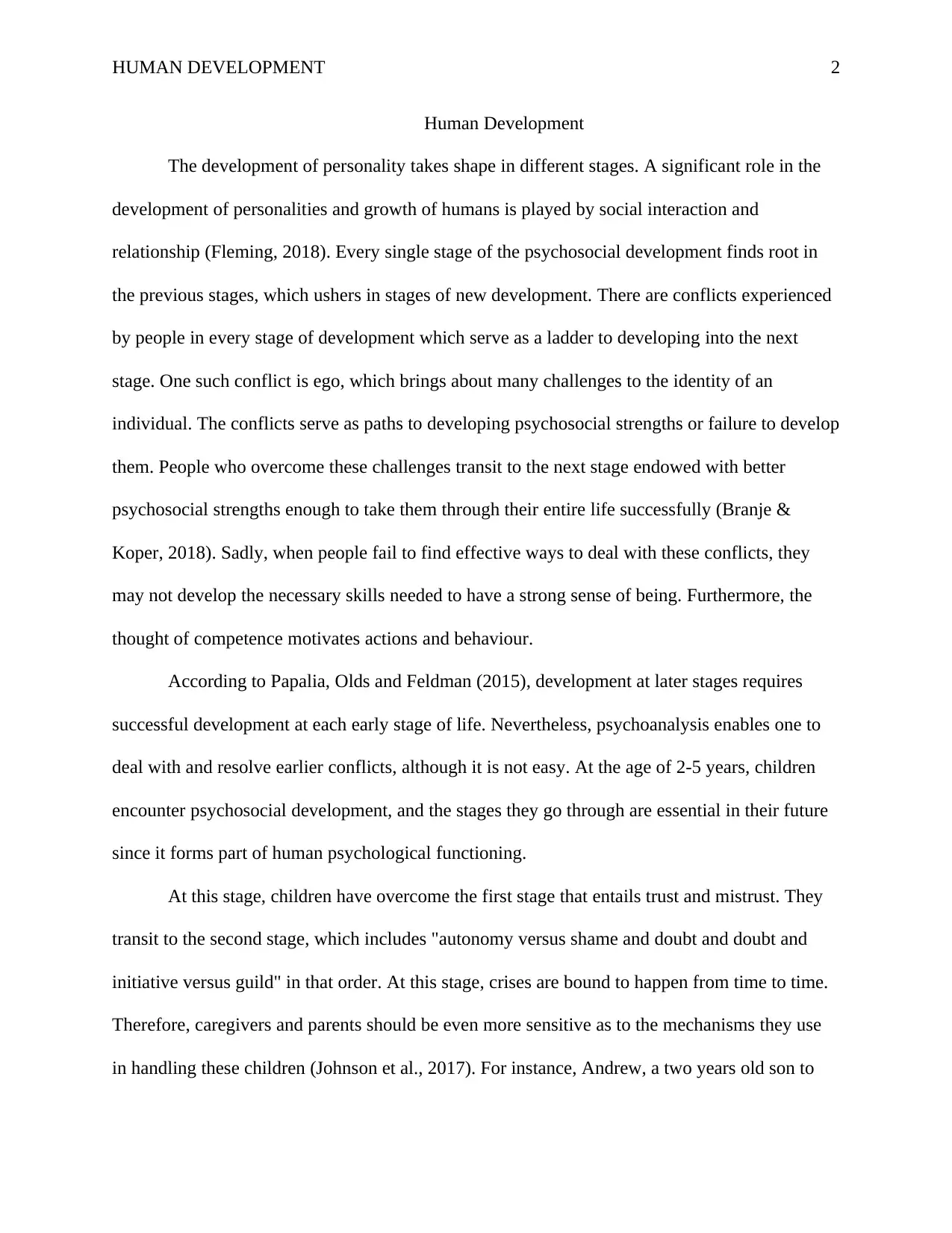
HUMAN DEVELOPMENT 2
Human Development
The development of personality takes shape in different stages. A significant role in the
development of personalities and growth of humans is played by social interaction and
relationship (Fleming, 2018). Every single stage of the psychosocial development finds root in
the previous stages, which ushers in stages of new development. There are conflicts experienced
by people in every stage of development which serve as a ladder to developing into the next
stage. One such conflict is ego, which brings about many challenges to the identity of an
individual. The conflicts serve as paths to developing psychosocial strengths or failure to develop
them. People who overcome these challenges transit to the next stage endowed with better
psychosocial strengths enough to take them through their entire life successfully (Branje &
Koper, 2018). Sadly, when people fail to find effective ways to deal with these conflicts, they
may not develop the necessary skills needed to have a strong sense of being. Furthermore, the
thought of competence motivates actions and behaviour.
According to Papalia, Olds and Feldman (2015), development at later stages requires
successful development at each early stage of life. Nevertheless, psychoanalysis enables one to
deal with and resolve earlier conflicts, although it is not easy. At the age of 2-5 years, children
encounter psychosocial development, and the stages they go through are essential in their future
since it forms part of human psychological functioning.
At this stage, children have overcome the first stage that entails trust and mistrust. They
transit to the second stage, which includes "autonomy versus shame and doubt and doubt and
initiative versus guild" in that order. At this stage, crises are bound to happen from time to time.
Therefore, caregivers and parents should be even more sensitive as to the mechanisms they use
in handling these children (Johnson et al., 2017). For instance, Andrew, a two years old son to
Human Development
The development of personality takes shape in different stages. A significant role in the
development of personalities and growth of humans is played by social interaction and
relationship (Fleming, 2018). Every single stage of the psychosocial development finds root in
the previous stages, which ushers in stages of new development. There are conflicts experienced
by people in every stage of development which serve as a ladder to developing into the next
stage. One such conflict is ego, which brings about many challenges to the identity of an
individual. The conflicts serve as paths to developing psychosocial strengths or failure to develop
them. People who overcome these challenges transit to the next stage endowed with better
psychosocial strengths enough to take them through their entire life successfully (Branje &
Koper, 2018). Sadly, when people fail to find effective ways to deal with these conflicts, they
may not develop the necessary skills needed to have a strong sense of being. Furthermore, the
thought of competence motivates actions and behaviour.
According to Papalia, Olds and Feldman (2015), development at later stages requires
successful development at each early stage of life. Nevertheless, psychoanalysis enables one to
deal with and resolve earlier conflicts, although it is not easy. At the age of 2-5 years, children
encounter psychosocial development, and the stages they go through are essential in their future
since it forms part of human psychological functioning.
At this stage, children have overcome the first stage that entails trust and mistrust. They
transit to the second stage, which includes "autonomy versus shame and doubt and doubt and
initiative versus guild" in that order. At this stage, crises are bound to happen from time to time.
Therefore, caregivers and parents should be even more sensitive as to the mechanisms they use
in handling these children (Johnson et al., 2017). For instance, Andrew, a two years old son to
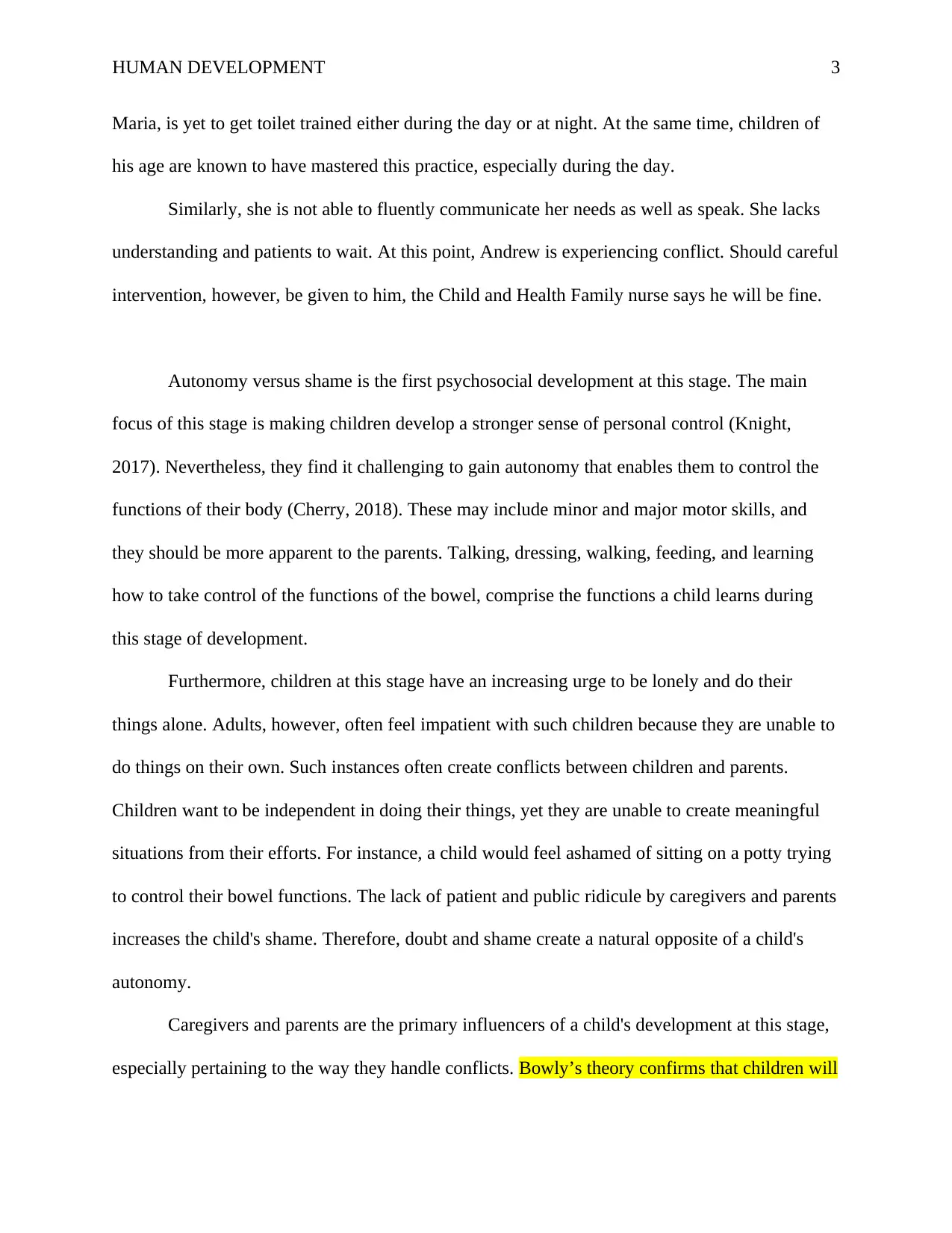
HUMAN DEVELOPMENT 3
Maria, is yet to get toilet trained either during the day or at night. At the same time, children of
his age are known to have mastered this practice, especially during the day.
Similarly, she is not able to fluently communicate her needs as well as speak. She lacks
understanding and patients to wait. At this point, Andrew is experiencing conflict. Should careful
intervention, however, be given to him, the Child and Health Family nurse says he will be fine.
Autonomy versus shame is the first psychosocial development at this stage. The main
focus of this stage is making children develop a stronger sense of personal control (Knight,
2017). Nevertheless, they find it challenging to gain autonomy that enables them to control the
functions of their body (Cherry, 2018). These may include minor and major motor skills, and
they should be more apparent to the parents. Talking, dressing, walking, feeding, and learning
how to take control of the functions of the bowel, comprise the functions a child learns during
this stage of development.
Furthermore, children at this stage have an increasing urge to be lonely and do their
things alone. Adults, however, often feel impatient with such children because they are unable to
do things on their own. Such instances often create conflicts between children and parents.
Children want to be independent in doing their things, yet they are unable to create meaningful
situations from their efforts. For instance, a child would feel ashamed of sitting on a potty trying
to control their bowel functions. The lack of patient and public ridicule by caregivers and parents
increases the child's shame. Therefore, doubt and shame create a natural opposite of a child's
autonomy.
Caregivers and parents are the primary influencers of a child's development at this stage,
especially pertaining to the way they handle conflicts. Bowly’s theory confirms that children will
Maria, is yet to get toilet trained either during the day or at night. At the same time, children of
his age are known to have mastered this practice, especially during the day.
Similarly, she is not able to fluently communicate her needs as well as speak. She lacks
understanding and patients to wait. At this point, Andrew is experiencing conflict. Should careful
intervention, however, be given to him, the Child and Health Family nurse says he will be fine.
Autonomy versus shame is the first psychosocial development at this stage. The main
focus of this stage is making children develop a stronger sense of personal control (Knight,
2017). Nevertheless, they find it challenging to gain autonomy that enables them to control the
functions of their body (Cherry, 2018). These may include minor and major motor skills, and
they should be more apparent to the parents. Talking, dressing, walking, feeding, and learning
how to take control of the functions of the bowel, comprise the functions a child learns during
this stage of development.
Furthermore, children at this stage have an increasing urge to be lonely and do their
things alone. Adults, however, often feel impatient with such children because they are unable to
do things on their own. Such instances often create conflicts between children and parents.
Children want to be independent in doing their things, yet they are unable to create meaningful
situations from their efforts. For instance, a child would feel ashamed of sitting on a potty trying
to control their bowel functions. The lack of patient and public ridicule by caregivers and parents
increases the child's shame. Therefore, doubt and shame create a natural opposite of a child's
autonomy.
Caregivers and parents are the primary influencers of a child's development at this stage,
especially pertaining to the way they handle conflicts. Bowly’s theory confirms that children will
⊘ This is a preview!⊘
Do you want full access?
Subscribe today to unlock all pages.

Trusted by 1+ million students worldwide
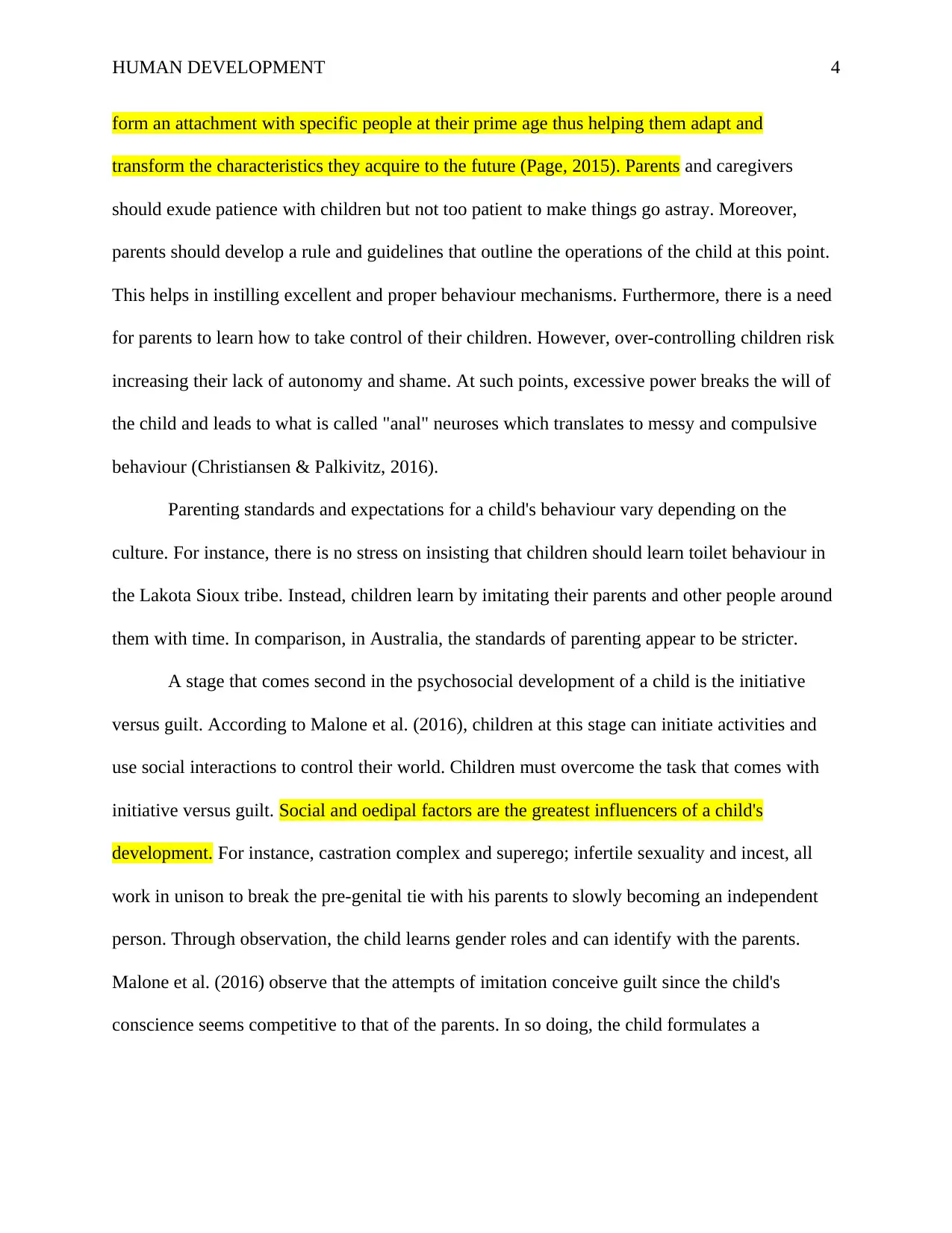
HUMAN DEVELOPMENT 4
form an attachment with specific people at their prime age thus helping them adapt and
transform the characteristics they acquire to the future (Page, 2015). Parents and caregivers
should exude patience with children but not too patient to make things go astray. Moreover,
parents should develop a rule and guidelines that outline the operations of the child at this point.
This helps in instilling excellent and proper behaviour mechanisms. Furthermore, there is a need
for parents to learn how to take control of their children. However, over-controlling children risk
increasing their lack of autonomy and shame. At such points, excessive power breaks the will of
the child and leads to what is called "anal" neuroses which translates to messy and compulsive
behaviour (Christiansen & Palkivitz, 2016).
Parenting standards and expectations for a child's behaviour vary depending on the
culture. For instance, there is no stress on insisting that children should learn toilet behaviour in
the Lakota Sioux tribe. Instead, children learn by imitating their parents and other people around
them with time. In comparison, in Australia, the standards of parenting appear to be stricter.
A stage that comes second in the psychosocial development of a child is the initiative
versus guilt. According to Malone et al. (2016), children at this stage can initiate activities and
use social interactions to control their world. Children must overcome the task that comes with
initiative versus guilt. Social and oedipal factors are the greatest influencers of a child's
development. For instance, castration complex and superego; infertile sexuality and incest, all
work in unison to break the pre-genital tie with his parents to slowly becoming an independent
person. Through observation, the child learns gender roles and can identify with the parents.
Malone et al. (2016) observe that the attempts of imitation conceive guilt since the child's
conscience seems competitive to that of the parents. In so doing, the child formulates a
form an attachment with specific people at their prime age thus helping them adapt and
transform the characteristics they acquire to the future (Page, 2015). Parents and caregivers
should exude patience with children but not too patient to make things go astray. Moreover,
parents should develop a rule and guidelines that outline the operations of the child at this point.
This helps in instilling excellent and proper behaviour mechanisms. Furthermore, there is a need
for parents to learn how to take control of their children. However, over-controlling children risk
increasing their lack of autonomy and shame. At such points, excessive power breaks the will of
the child and leads to what is called "anal" neuroses which translates to messy and compulsive
behaviour (Christiansen & Palkivitz, 2016).
Parenting standards and expectations for a child's behaviour vary depending on the
culture. For instance, there is no stress on insisting that children should learn toilet behaviour in
the Lakota Sioux tribe. Instead, children learn by imitating their parents and other people around
them with time. In comparison, in Australia, the standards of parenting appear to be stricter.
A stage that comes second in the psychosocial development of a child is the initiative
versus guilt. According to Malone et al. (2016), children at this stage can initiate activities and
use social interactions to control their world. Children must overcome the task that comes with
initiative versus guilt. Social and oedipal factors are the greatest influencers of a child's
development. For instance, castration complex and superego; infertile sexuality and incest, all
work in unison to break the pre-genital tie with his parents to slowly becoming an independent
person. Through observation, the child learns gender roles and can identify with the parents.
Malone et al. (2016) observe that the attempts of imitation conceive guilt since the child's
conscience seems competitive to that of the parents. In so doing, the child formulates a
Paraphrase This Document
Need a fresh take? Get an instant paraphrase of this document with our AI Paraphraser
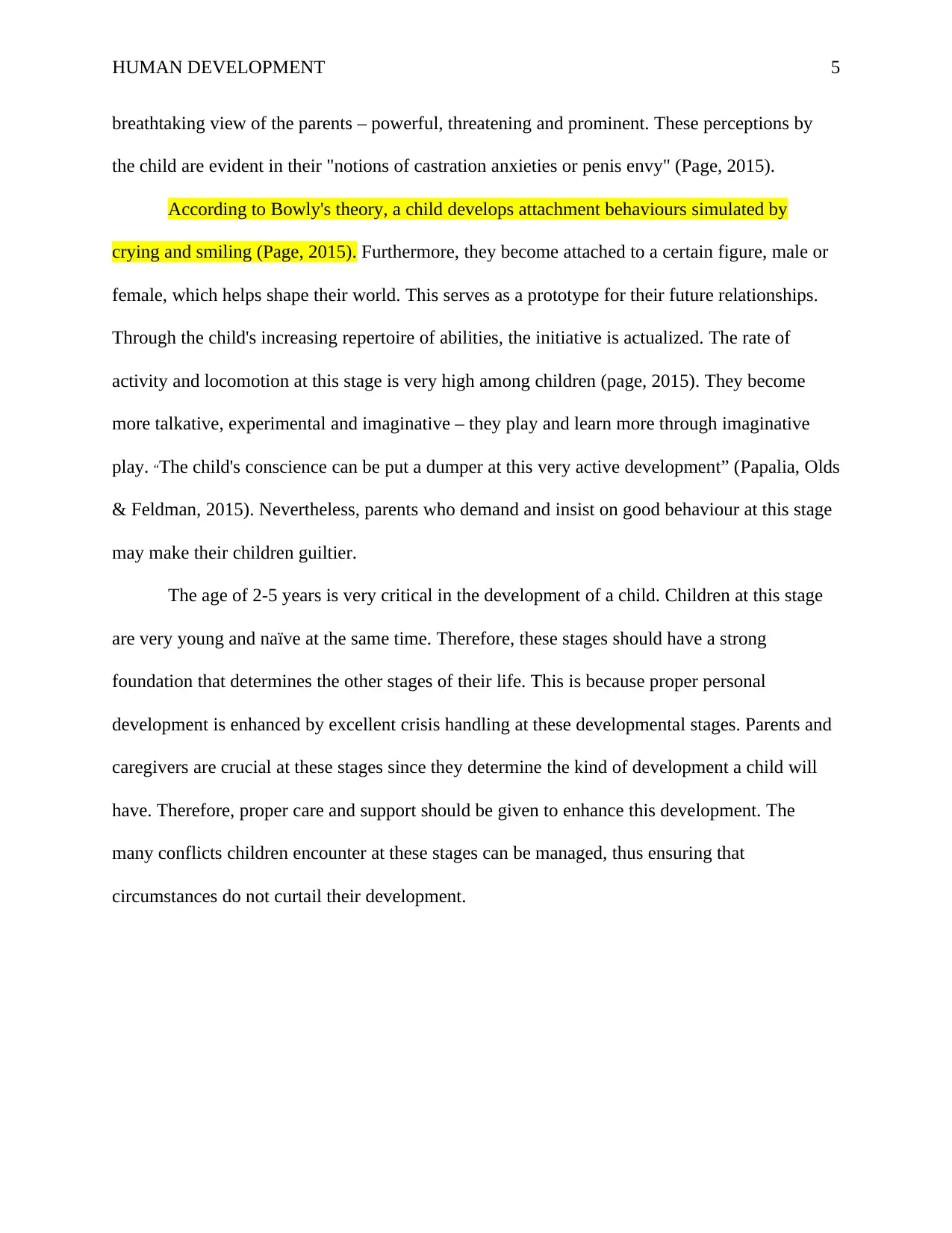
HUMAN DEVELOPMENT 5
breathtaking view of the parents – powerful, threatening and prominent. These perceptions by
the child are evident in their "notions of castration anxieties or penis envy" (Page, 2015).
According to Bowly's theory, a child develops attachment behaviours simulated by
crying and smiling (Page, 2015). Furthermore, they become attached to a certain figure, male or
female, which helps shape their world. This serves as a prototype for their future relationships.
Through the child's increasing repertoire of abilities, the initiative is actualized. The rate of
activity and locomotion at this stage is very high among children (page, 2015). They become
more talkative, experimental and imaginative – they play and learn more through imaginative
play. “The child's conscience can be put a dumper at this very active development” (Papalia, Olds
& Feldman, 2015). Nevertheless, parents who demand and insist on good behaviour at this stage
may make their children guiltier.
The age of 2-5 years is very critical in the development of a child. Children at this stage
are very young and naïve at the same time. Therefore, these stages should have a strong
foundation that determines the other stages of their life. This is because proper personal
development is enhanced by excellent crisis handling at these developmental stages. Parents and
caregivers are crucial at these stages since they determine the kind of development a child will
have. Therefore, proper care and support should be given to enhance this development. The
many conflicts children encounter at these stages can be managed, thus ensuring that
circumstances do not curtail their development.
breathtaking view of the parents – powerful, threatening and prominent. These perceptions by
the child are evident in their "notions of castration anxieties or penis envy" (Page, 2015).
According to Bowly's theory, a child develops attachment behaviours simulated by
crying and smiling (Page, 2015). Furthermore, they become attached to a certain figure, male or
female, which helps shape their world. This serves as a prototype for their future relationships.
Through the child's increasing repertoire of abilities, the initiative is actualized. The rate of
activity and locomotion at this stage is very high among children (page, 2015). They become
more talkative, experimental and imaginative – they play and learn more through imaginative
play. “The child's conscience can be put a dumper at this very active development” (Papalia, Olds
& Feldman, 2015). Nevertheless, parents who demand and insist on good behaviour at this stage
may make their children guiltier.
The age of 2-5 years is very critical in the development of a child. Children at this stage
are very young and naïve at the same time. Therefore, these stages should have a strong
foundation that determines the other stages of their life. This is because proper personal
development is enhanced by excellent crisis handling at these developmental stages. Parents and
caregivers are crucial at these stages since they determine the kind of development a child will
have. Therefore, proper care and support should be given to enhance this development. The
many conflicts children encounter at these stages can be managed, thus ensuring that
circumstances do not curtail their development.
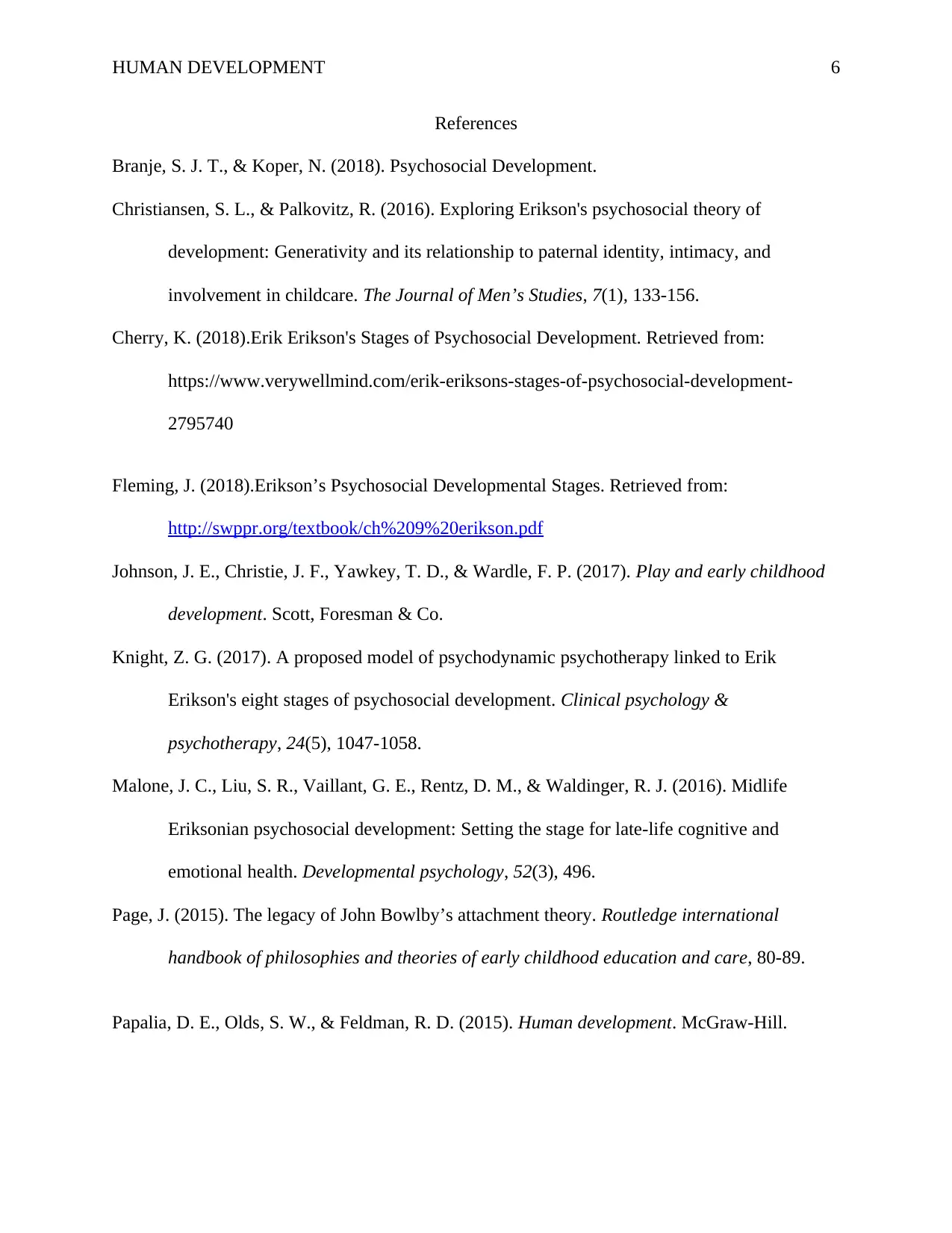
HUMAN DEVELOPMENT 6
References
Branje, S. J. T., & Koper, N. (2018). Psychosocial Development.
Christiansen, S. L., & Palkovitz, R. (2016). Exploring Erikson's psychosocial theory of
development: Generativity and its relationship to paternal identity, intimacy, and
involvement in childcare. The Journal of Men’s Studies, 7(1), 133-156.
Cherry, K. (2018).Erik Erikson's Stages of Psychosocial Development. Retrieved from:
https://www.verywellmind.com/erik-eriksons-stages-of-psychosocial-development-
2795740
Fleming, J. (2018).Erikson’s Psychosocial Developmental Stages. Retrieved from:
http://swppr.org/textbook/ch%209%20erikson.pdf
Johnson, J. E., Christie, J. F., Yawkey, T. D., & Wardle, F. P. (2017). Play and early childhood
development. Scott, Foresman & Co.
Knight, Z. G. (2017). A proposed model of psychodynamic psychotherapy linked to Erik
Erikson's eight stages of psychosocial development. Clinical psychology &
psychotherapy, 24(5), 1047-1058.
Malone, J. C., Liu, S. R., Vaillant, G. E., Rentz, D. M., & Waldinger, R. J. (2016). Midlife
Eriksonian psychosocial development: Setting the stage for late-life cognitive and
emotional health. Developmental psychology, 52(3), 496.
Page, J. (2015). The legacy of John Bowlby’s attachment theory. Routledge international
handbook of philosophies and theories of early childhood education and care, 80-89.
Papalia, D. E., Olds, S. W., & Feldman, R. D. (2015). Human development. McGraw-Hill.
References
Branje, S. J. T., & Koper, N. (2018). Psychosocial Development.
Christiansen, S. L., & Palkovitz, R. (2016). Exploring Erikson's psychosocial theory of
development: Generativity and its relationship to paternal identity, intimacy, and
involvement in childcare. The Journal of Men’s Studies, 7(1), 133-156.
Cherry, K. (2018).Erik Erikson's Stages of Psychosocial Development. Retrieved from:
https://www.verywellmind.com/erik-eriksons-stages-of-psychosocial-development-
2795740
Fleming, J. (2018).Erikson’s Psychosocial Developmental Stages. Retrieved from:
http://swppr.org/textbook/ch%209%20erikson.pdf
Johnson, J. E., Christie, J. F., Yawkey, T. D., & Wardle, F. P. (2017). Play and early childhood
development. Scott, Foresman & Co.
Knight, Z. G. (2017). A proposed model of psychodynamic psychotherapy linked to Erik
Erikson's eight stages of psychosocial development. Clinical psychology &
psychotherapy, 24(5), 1047-1058.
Malone, J. C., Liu, S. R., Vaillant, G. E., Rentz, D. M., & Waldinger, R. J. (2016). Midlife
Eriksonian psychosocial development: Setting the stage for late-life cognitive and
emotional health. Developmental psychology, 52(3), 496.
Page, J. (2015). The legacy of John Bowlby’s attachment theory. Routledge international
handbook of philosophies and theories of early childhood education and care, 80-89.
Papalia, D. E., Olds, S. W., & Feldman, R. D. (2015). Human development. McGraw-Hill.
⊘ This is a preview!⊘
Do you want full access?
Subscribe today to unlock all pages.

Trusted by 1+ million students worldwide
1 out of 6
Related Documents
Your All-in-One AI-Powered Toolkit for Academic Success.
+13062052269
info@desklib.com
Available 24*7 on WhatsApp / Email
![[object Object]](/_next/static/media/star-bottom.7253800d.svg)
Unlock your academic potential
Copyright © 2020–2025 A2Z Services. All Rights Reserved. Developed and managed by ZUCOL.




